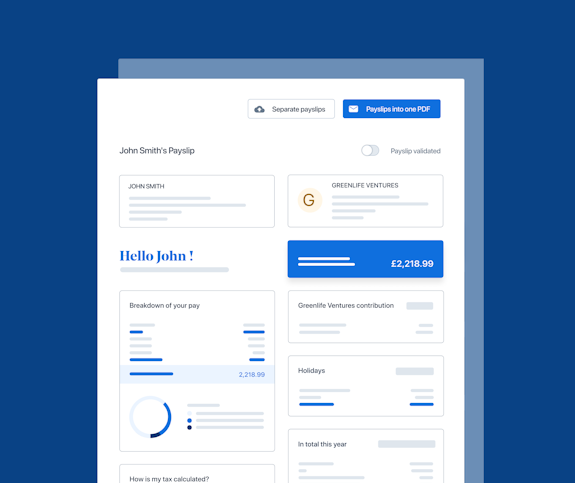- Blog
- |Managing Payroll
- >PAYE and Tax
- >submitting an FPS to HMRC
A Guide to Submitting an FPS to HMRC


All employers using the Pay As You Earn (PAYE) payroll system are required by UK laws to make specific submissions every month.
One such submission is a Full Payment Submission (FPS) to HMRC.
This guide will take you through all the critical information you need to know about a Full Payment Submission, including who you’re to submit to, when, and so on.
Let’s start with the basics.
What is a Full Payment Submission?
A Full Payment Submission (FPS) is the primary submission employers must make to His Majesty’s Revenue & Customs (HMRC) each time they pay their employees.
An FPS is part of the Real Time Information (RTI) system. And its purpose is to inform HMRC of each employee’s personal information, payment details, and any deductions you might have made to their pay.
What information should you include in an FPS?
Here are some details you should include in a typical Full Payment Submission to HMRC.
Employer information: Your submission should include your HMRC office number, Employer PAYE reference, Accounts Office reference, and tax year when you’re making the report. Depending on your business type, you might need to include your COTAX reference or Employer’s Contracted Out Number.
Employee information: Every FPS should report your employee’s details like their National Insurance number, full name, date of birth, gender, payroll ID, and address.
Information about your employee’s pay and deductions: You should report each employer’s taxable pay, pay after deductions, National Insurance contribution payments, student loan repayments, and so on. In addition, you should also include other details like their tax code, payment date, pay frequency, and tax month number.
You can find a complete list of the payroll information you’re expected to submit to HMRC in this guide.
How is an FPS submitted?
Now that you know the details to include in an FPS, how do you make your submission?
One of the easiest ways to make a Full Payment Submission to HMRC is with software. First, you’ll be expected to input your employees' details into your payroll software. After which, you should follow the software’s prompts/instructions on how to make a final submission.
A payroll software like PayFit helps employers record their employee’s pay and calculate deductions like NIC, tax, and student loan repayments, so the submissions require less hassle and are more accurate.
When should you submit an FPS to HMRC?
You must submit the FPS to HMRC on or before your employee’s payday.
On occasions when you pay your employees early — say the payday falls on a Bank Holiday — you should still use the agreed payday in your submission.
Although it’s essential to submit the FPS early, it shouldn’t be too early because some changes (like an employee leaving or changing their tax code) might occur, which will require a Full Payment Submission adjustment.
Here is HMRC’s guide on how to make corrections to your FPS.
What if you submit an FPS after your employee’s payday?
You can submit an FPS after your employee’s payday if you provide HMRC with a valid reason for the late submission.
HMRC provides a list of valid situations for late submission and when to submit the FPS when those situations arise.
One of two things will happen if you submit an FPS late without a valid reason:
You might receive a penalty warning message if it’s the first time you missed a submission on or before a payday.
You might be charged a penalty.
The penalty charge depends on how many employees you have.
Employers with 1-9 employees are charged a monthly penalty of £100; those with 10-49 employees are charged £200; £300 if you have 50-249 employees; and £100 if you employ more than 250 people.
This penalty accrues daily interest if it’s not paid on time.
What additional information might need to be reported on an FPS?
You should include more information when submitting an FPS if:
You hired a new employee. You should include a new employee’s details on the FSP on their first payday. These details include the employee’s tax code, starter declaration, pay and deductions since you employed them, and any other information from their P45 form.
An employee leaves. Here’s HMRC’s guide on how to handle submitting an FPS when an employee leaves.
You’re sending in your final payroll report. This payroll report should come in on or before your employees’ last payday within a tax year (meaning it’s due on 5 April).
How does PayFit help businesses carry out an FPS?
PayFit can help you calculate your employees’ pay and make accurate deductions. Furthermore, it can help you handle all FPS reporting to HMRC. That way, you’ll never have to worry about late submissions, penalties, or additional planning.
Book a free demo today to learn more about managing your payroll and making simple Full Payment Submissions.


A UK 4-Day Working Week - Thoughts On Labour’s Plan

Running payroll - A Guide For New Businesses

The Alabaster Ruling & Maternity Pay - A Guide For Employers

The End Of Zero Hours Contracts? Implications For Businesses

What is the HM Revenue and Customs Starter Checklist

